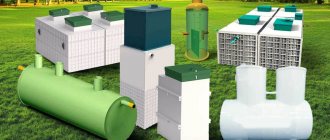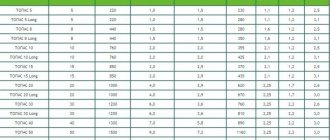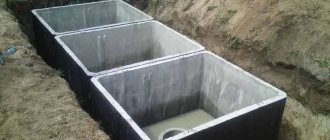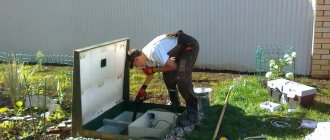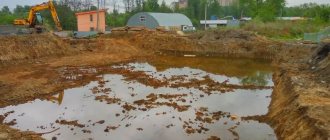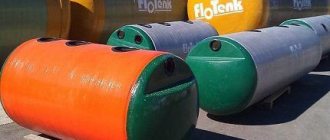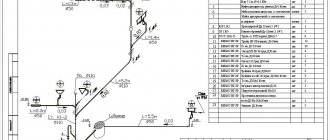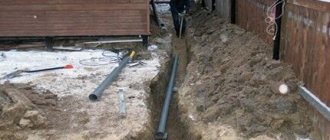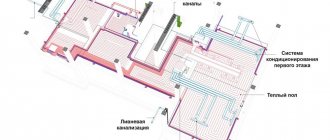Autonomous sewerage and septic tanks are equipment used to treat wastewater from a country house, country house, cottage, etc. However, these structures have different technical and design characteristics, as well as operating principles. We asked the Group’s specialists, who are engaged in the development, production and installation of wastewater treatment systems, to talk about them in detail.
Plastic type of septic tank for arrangement on the territory of the house Source tdomru.ru
Purpose
A septic tank, like an autonomous sewer system, plays a similar role in the local area. They are designed to collect wastewater and biological waste for further processing in various ways. We suggest that you contact each equipment separately and find out all the details.
Septic tank function
A septic tank is a system that consists of several overflow tanks buried deep in the ground. They collect (accumulate) biological waste, which is subsequently processed through fermentation. There is no oxygen supplied to the septic tank, and all waste is contained in a closed compartment.
Wastewater treatment occurs with maximum efficiency, which also shows the difference between a septic tank and an autonomous sewer system (efficiency). The quality of cleaning in connected tanks is no more than 65-85%. From a professional point of view, a septic tank is designed to collect wastewater and biological waste for further disposal through soil. Various technologies can be used to process the contents in tanks, and performance depends directly on the design features of the septic tank on the site.
Autonomous sewer function
Autonomous sewerage is a system of combined biological treatment of household wastewater (aerobic, anaerobic, anoxic). This technology involves step-by-step purification using forced aeration of a mixture of wastewater and activated sludge (used in TOPOL-ECO products (TOPAS stations)). After complete processing, the resulting liquid does not require additional purification. With correct operation of the station, cleaning is up to 98%.
Both the septic tank and the autonomous sewer system perform identical functions. The difference is the method used to treat wastewater.
conclusions
The most effective method of dissolving sludge in a cesspool is the use of bacteria . To get a quick result, they must first be prepared and only then poured into a cesspool. After this, for at least 1-2 months you should not pour products that cause the death of bacteria into the sewer. Otherwise there will be no effect. Also, do not use chemicals to dissolve sludge in a cesspool. They will help only for a short time, but will lead to contamination of the soil on the site and groundwater.
The main thing is to always remember that careful handling of the cesspool is the key to its long and trouble-free operation.
We hope that the article helped you figure out how and how to quickly dissolve sludge in a cesspool without the use of chemicals. If you want to share your experience or simply speak on the topic, we are waiting for your comment.
Advantages and disadvantages
The pros and cons of a septic tank and autonomous sewage system will also help you decide which option is worth installing.
Advantages of a septic tank:
- autonomy (does not require electricity);
- variety of options and volumes;
- simplicity of design;
- relatively simple installation;
- price.
Flaws:
- low quality of cleaning;
- long cleaning process;
- requires a large free area for installation;
- cannot be used in all types of soil;
- limited range of occurrence of inlet and outlet communications;
- binding to the specified direction of the inlet and outlet pipelines by the manufacturer.
Advantages of autonomous sewerage:
- reduced wastewater treatment time;
- high quality cleaning;
- no odor;
- long service life with timely maintenance;
- quiet operation;
- no need to call sewage disposal equipment;
- low power consumption;
- for vertical design – low installation cost;
- Possibility of application in various types of soil;
- no restrictions regarding the directions of disposal of purified water;
- the ability to select an installation in accordance with the depth of the pipeline.
Minuses:
- the need to connect to electricity;
- processing is suspended due to power outages; without electricity it works as a storage tank (the same septic tank) after starting it goes into operating mode
- requires mandatory cleaning of sludge, as it tends to harden. Please do not forget that the septic tank also needs to be cleaned using special equipment, unlike the WWTP! And “hardening” occurs in the septic tank, but in many of them the design does not allow cleaning of solid sediments and the useful volume decreases!
This is what the pros and cons of a septic tank and autonomous sewage system look like. Pay attention to them when you are faced with choosing a suitable design.
Autonomous sewage system that takes up little space on the site Source construction-shakhovskaya.rf
Operating principle of a cesspool
The sewage pit works on a very simple principle - solids settle at the bottom, and water flows through the windows in the walls and the bottom into the ground. Such structures are built in areas with low groundwater levels, otherwise the septic tank will quickly fill up. Its depth rarely exceeds 3 meters. Contaminated liquid from wastewater decomposes naturally. However, when filling it, the pit must be pumped out mechanically.
The classic option is an absorption-type cesspool. Essentially it is a filter tank with windows in the walls. At the bottom there is a layer of gravel, crushed stone or sand. Such structures are the most economical; part of the wastewater goes into the ground on its own. The intervals between pumpings are longer than with the sealed type.
If the groundwater level is quite high, completely sealed structures are used. The walls are made of different materials, most often brick or concrete rings. The bottom is filled with a layer of cement mortar.
To increase the efficiency of wastewater decomposition, it is recommended to introduce biological products. However, regular mechanical pumping using a pump or using special equipment will still be required.
What is the difference and how it works
This section provides a comparison of a septic tank and an autonomous sewer system in the form of a table so that at the planning stage of the system the owner can determine for himself the necessary qualities and in the future not regret the perfect structure.
| Characteristics | Septic tank | Autonomous sewerage |
| Oxygen supply | No | Yes (artificial, directly into the treatment well) |
| Selection of conditions for construction | Strictly on an individual site (away from buildings) THERE ARE strict restrictions | In any place in the local area (even near the house) it is regulated |
| Features of the modification | Available in different tank options, it is possible to make the design yourself | Factory design, do not do it yourself due to the possibility of making mistakes. What does this mean? |
| Efficiency | 85% | 99% |
| Autonomy | Functions autonomously | Requires a mandatory connection to the electrical network |
| Sealing property | Possible unpleasant odor | Complete absence of fumes during processing Unclear |
Here you can clearly see the differences between a septic tank and an autonomous sewer system. It is worth noting that in fact, an autonomous sewer system will function better, but whether it is needed should be determined based on the number of people living in the house and the number of points that will remove biological waste.
On a note! For a large mansion or two-story cottage, it is recommended to give preference to an autonomous sewage system. It will be more productive and will eliminate any evaporation that could harm the fresh air in the area.
The principle of operation of a septic tank
To understand the difference between a septic tank and an autonomous sewer system, you need to understand the principle of their operation. The choice of device for processing biological waste also depends on this. The processing process is an organization of the natural settling process. Until the septic tank is filled, the process of separating liquid from more solid waste is carried out, and some biological particles float to the top.
The purer liquid remains in the center of the column. At this level there is also an overflow, which will discharge purified water to the specified conditions (special design for collection).
A device inside a septic tank installed on an area already filled with liquid Source septik-good.ru
In addition to natural settling, there is the option of anaerobic digestion. It involves the processing of organic sediment that accumulates at the bottom through exposure to bacteria that enter the septic tank along with the wastewater. As a result, the contents of the sediment are gradually destroyed, and its quantity, accordingly, decreases.
Scheme of moving waste in a septic tank at a summer cottage Source faqindecor.com
In fact, none of the cleaning methods performs it thoroughly in a septic tank; accordingly, it is directly prohibited to discharge treated waste into the soil or reservoir. From the septic tank, the wastewater must be moved to a special structure, where it will undergo an additional cleaning procedure. For this purpose, special structures are constructed, equipped with sand and gravel filtration systems. And only after final processing can water be released into the external environment. In principle, this is all the difference between a septic tank and an autonomous sewer system.
Operating principle of autonomous sewage system
An autonomous sewer system also involves the use of a settling method for cleaning. All processing, as indicated in the comparative table, is carried out under the condition of oxygen supply. Thanks to its access, the quality of purification can reach 97-99%, and the decomposition of biological waste is almost complete. Therefore, the treated liquid can be safely discharged into water bodies or used for technical purposes. Thanks to such a high efficiency, there is no need to build an additional filtration platform.
Internal review of autonomous sewerage cameras Source rtbaza.ru
Let's look at the example of the TOPAS deep biological treatment station.
The installation has 4 cameras:
- receiving chamber;
- aeration chamber;
- secondary settling tank;
- sludge settling tank.
The receiving chamber receives wastewater from the sewer pipe. After preliminary settling, wastewater from the receiving chamber passes through a coarse filter and, through an airlift, enters the aeration tank chamber for cleaning. In it, accelerated oxidation of organic matter occurs and mixing of liquid with small air bubbles (a process called aeration), due to which microorganisms naturally develop that feed on contaminants, thereby purifying wastewater. Next, the liquid enters the secondary settling tank, where separation of liquid and activated sludge occurs. Purified water is removed from the installation.
From the aeration tank chamber, excess stabilized sludge is pumped into the sludge settling chamber. The concentration of which, as it accumulates, can be reduced using the built-in air lift or with the help of qualified technical service personnel during scheduled maintenance.
The autonomous sewer system has a factory internal structure Source topas-lobnya.ru
At this stage, the owner must determine for himself, based on the data obtained about the principle of operation and features of the structures, which is better: a septic tank or an autonomous sewer system.
The most modern technologies
There are more modern methods of wastewater treatment. They are not yet practiced very often due to their high cost. However, it is quite possible that they will soon supplant all other options.
Modern methods of wastewater treatment:
- Electrochemical. They are based on the use of cathodic reduction and anodic oxidation.
- Membrane cleaning method. It involves the use of ultrafiltration and electrodialysis.
- A magnetic method that allows increasing the flotation of suspended particles.
- Ozonation is also considered a good way to treat wastewater.
These methods are very modern. They allow you to purify water almost 100%. Therefore, they are already used in enterprises.
There are many methods for cleaning wastewater from sewers. For private homes, biological and mechanical septic tanks are best suited.
What is better to choose and under what conditions will the choice be justified?
Having figured out how a septic tank differs from an autonomous sewer system, you can begin choosing a device for your site. But it's not that simple. It is important to understand for what purposes the structure will be used. It also all depends on the conditions that the local area meets.
An autonomous sewer system is equipped with a post-treatment station, if it is necessary to discharge residues into a reservoir Source quartz-stroy.rf
So, when choosing a septic tank and autonomous sewage system, you need to pay attention to:
- the type of soil in the area where it is planned to install the system;
- number of people in the house (if the family is large, then autonomous sewerage is definitely a priority);
- the number of wastewater transferred to the treatment system;
- temperature conditions;
- consistency of operation (if the structure is being built for a residential building, then it is better to give preference to an autonomous sewage system, since it will be larger and faster to process biological waste).
Note! A septic tank is often a temporary structure if it is not part of an autonomous sewer system. Ideal for collecting small amounts of waste and infrequently refilling containers.
How to clean a hole using folk remedies
A cesspool can be cleaned without pumping using traditional methods. This is often necessary when the cesspool has a small volume. In this case, calling a vacuum cleaner is unreasonably expensive.
Below are the most effective methods from resourceful summer residents:
- Sawdust - natural fibers perfectly absorb moisture, gases and odor. Phytoncides contained in conifers neutralize the effect of pathogenic microorganisms. For greater efficiency, sawdust should be of a minimum size.
- Nettle - reacts with organic waste, thereby disinfecting wastewater. The active ingredient is oxalic acid.
- Tops (potatoes, peppers, eggplants), mint, basil - have antiseptic properties, remove unpleasant odors, and slow down the development of bacteria.
Products of natural origin form safe raw materials for compost. However, the use of such methods will not eliminate the need to pump out the tank. Water is absorbed by the soil, partially evaporates, and solid waste remains. Sooner or later, you will still have to remove them yourself or call specialists.
Installation
This section will discuss how to install an autonomous sewer and septic tank. To do this, detailed instructions with step-by-step actions are provided below. Ideally, each job should be completed in stages. This will ensure correct operation and protect against critical errors.
Installation of a septic tank in a pit can be done with additional reinforcement in the form of reinforcing mesh Source kanalizaciyam.ru
Installation of a septic tank on the site step by step
Since there is a need to construct a system at a summer cottage, in this case the question of what is better: a septic tank or an autonomous sewer system is not appropriate. It is definitely more rational to install a septic tank. In this section you can learn how to install it.
When installing a septic tank, it is necessary to check the structure for absence of slope Source eurolos.ru
Stage one: selection and preparation of installation site
Choosing the right location is already half the success. At this stage, you should be guided by the following factors:
- is it possible for a sewer truck to approach the septic tank for pumping;
- distance from a reservoir, well, water supply system by at least 10 meters;
- the distance from a residential building should not be less than 6 meters, ideally 20 meters;
- It should be possible to lay a straight sewer pipe (without bending);
- the ability to deepen the septic tank so that its intake hole is lower (this will prevent stagnation of waste in the pipe, and as a result, the formation of a blockage).
After deciding the difference between a septic tank and an autonomous sewer system and taking into account the listed factors, you can begin preparing the pit. This process is simple, the most important thing is to correctly determine the size. To do this, you will first have to buy the tank itself and its accessories. Based on the volume of the selected container, you can start digging a pit.
Strengthening the pit for a septic tank can be done using monolithic finishing Source remontnik.ru
It is imperative that when the pit is prepared, it is necessary to install a waste receiving tank in it on the same day. Otherwise, there is a risk that a collapse will occur or the interior will fill with groundwater.
Stage two: features of septic tank installation
It is advisable to install a septic tank with assistants. For this purpose you will need 4 people. It is necessary to thread the ropes into the technological protrusions and then use them to lower the structure into the prepared pit.
Be sure to set it level. To do this, you can stand on top of the septic tank and swing it in different directions to catch the parallel to the bottom. If there is still a slope, you can backfill the bottom of the septic tank with river sand. At the same time, it should be carefully compacted so that there is no overweight in the future.
The next step is to install thick corrugated pipes on the necks, fill the septic tank to the top with water (fill each compartment), and then close the hatches. Add sand into the cracks so that the structure is sealed and does not move randomly.
Important! It is allowed to leave a slope angle of 1 cm per 1 meter of length. This solution is appropriate for both an autonomous sewer system and a septic tank.
The street pipe to the septic tank is laid in insulation if it is laid above the freezing level of the soil Source sdelais.ru
The upper part of the septic tank must be covered with foam plastic so that during periods of severe frost the structure filled with waste does not deform. After the insulation has hardened, you can continue filling it with sand, after which you should pour water over the entire mass in order to create a higher density of the structure inside the pit.
Stage Three: Pipeline Installation
The laying of the pipeline leading to the septic tank is carried out using sewer pipes with a diameter of 110 mm. Please note that the street version will be orange. Models of pipes for wiring in a gray house.
Pull the pipe to the inlet at a slope of 3 cm for each linear meter. In no case should you make the slope steeper, otherwise the water will drain faster than feces, which will lead to stagnation and a gradual narrowing of the lumen in the pipe.
The installation of such an inspection well is mandatory when turning and crossing pipes in the ground Source sdelais.ru
All pipe connections must be made using sealants (special rubber bands). Their number is calculated depending on the number of sewer pipe closures. The pipe running along the street to the waste receptacle does not need insulation, since the liquid inside it does not stagnate. Of course, this is subject to a correctly executed slope and sufficient depth of immersion in the trench.
Stage four: planning the ventilation and drainage system
Ventilation for a septic tank is mandatory, as it will help quickly rid the container of stagnant processes and the spread of unpleasant odors. It happens that the factory septic tank comes with an outlet pipe included. If it is not there, then you will need a long gray sewer pipe with a diameter of 110 mm. You will definitely have to additionally purchase a special end cap with perforation. It may also look like a round lattice. The main thing is that it fits in diameter.
Ventilation for the septic tank is not provided by the factory, but it can be installed at the point where water is discharged into the ground Source bioprime.info
The septic tank ventilation pipe should be installed directly on the tank itself. If the corresponding hole is not provided by the container manufacturer, then ventilation must be installed at the stage of immersing the septic tank in the pit. Please note that the pipe must be raised high enough above ground level so that the air formed inside can escape freely.
On a note! Ventilation for a septic tank system is mandatory. Its presence will prevent the creation of a vacuum during flushing of biological waste. Otherwise, feces may backflow into the bathtub or toilet.
After fully organizing the wastewater system and ventilation in relation to the septic tank, it’s time to think about drainage, namely the method of draining the purified liquid.
The most alternative and financially beneficial option is surface drainage. It is configured as follows:
- A trench is prepared, the length of which is 10 meters, width - 0.4 m, depth - 0.5-0.6 m.
- Geotextiles are laid on top, then a perforated pipe is placed along the entire length of the trench at a slope of 1 cm for each meter of pipe.
- If there is a natural slope in the area where the pipe is laid, then there is no need to give it to the pipe.
- The next step is to secure the edges of the geotextile to the ground with pegs so that they do not curl up.
- Then the filling is done with crushed stone to the very top. It is advisable to use the middle fraction of the material, it will provide better drainage.
All that remains is to cover the trench with soil from above, and a full-fledged septic tank is ready for use.
Installation of autonomous sewage system on site: instructions
Installation of an autonomous sewer system, like a septic tank, is best started by preparing the installation location. The device must be located at a sufficient distance from residential buildings, neighbor’s fence and communications. In each specific case, the listed parameters may vary. Further all actions are performed according to the instructions:
- Prepare the pit according to the installation diagram, with the installation of formwork for your WWTP model.
- Apply sand evenly under the base, at least 150 mm.
- Lay the inlet/outlet pipeline to the entry point into the WWTP in accordance with the building codes.
- Lead the cable to the compressor compartment of the WWTP and insert it through a split HDPE outlet with a diameter of 20 mm.
- Lower the WWTP into the pit and level it horizontally and vertically (maximum deviation 5 mm).
- Cover the waste water treatment plant on all external sides with 300–400 mm of sand (GOST 8736–2014). 8. Fill the WWTP to the same height with water. Fill the WWTP evenly from all sides and at the same time fill it with water 1000 mm from the bottom of the WWTP.
- Make the inlet hole in accordance with the installation diagram; install the supplied pipe and solder it with a welding rod; connect the supply line to the branch pipe through a connecting or compensating coupling. Make an inlet hole in accordance with the installation diagram; install the supplied pipe and solder it with a welding rod; connect the supply line to the branch pipe through a connecting or compensating coupling.
- Lay a purified water pipeline to the discharge point.
- In WWTP models with a gravity outlet, connect the outlet pipe to the purified water drainage pipeline. In installations with forced discharge, make a Ø 25 or Ø 32 hole in either direction in the direction of discharge of purified water, insert the supplied pipe and seal it with a welding rod.
- Install and connect equipment to the installation.
- Cover the WWTP with sand to the ground level.
For biological treatment plants, all possible options for the removal of purified water are applicable in compliance with regulatory documents regarding placement, taking into account the type of soil.
The installed autonomous sewage system should not be completely immersed in the ground Source septikdom.com
After studying the installation principles, everyone will be able to decide for themselves whether a septic tank or an autonomous sewage system is better and for what conditions.
How to understand when it’s time to clean your cesspool
The cesspool is often made in the form of a sealed tank. Accordingly, all the contents of the wastewater are retained inside this container. To prevent the contents from overflowing beyond its limits, the design includes inspection doors and wells. Pumping can also be carried out through them. According to the standards, it is allowed to fill the container to two-thirds of the total volume.
In addition to visual inspection, there are three signs that indicate the need to clean the tank:
- the flow of water from plumbing equipment slows down;
- a gurgling sound appears in the sewer pipe;
- There is an unpleasant smell in the yard, and sometimes in the house.
In absorption-type pits, the drainage partially passes through the bottom, as well as through windows in the walls and goes into the ground. However, over time, the holes become clogged with solid particles, fats and silt. Therefore, it is recommended to regularly check how full the pit is and carry out cleaning in a timely manner.
Service
Knowing how a septic tank differs from an autonomous sewer system in terms of its internal structure and operating principle, it is necessary to understand the difference in maintenance. For example, it is best to perform a septic tank service only if the amount of solid waste occupies up to 20-25% of the total contents in the tank.
Cleaning the septic tank can be done manually using available tools Source allproseptictexas.com
For cleaning, it is better to involve a specialist in a sewer truck. Additionally, you can disinfect the tank using special solvents, and then thoroughly rinse the entire tank with a high-pressure stream of water.
On a note! Complete disinfection and thorough cleaning should be carried out no more than once a year. During the processing process, all pathogenic organisms that contribute to the natural fermentation of waste are destroyed. Therefore, processing will take a long time.
As for servicing an autonomous sewer system, it is best to involve the technical service of the station manufacturer in this process. Professionals will not only do a thorough washing with the help of equipment. Specialists will also help resolve any problems that arise.
It is better to entrust the cleaning of autonomous sewerage and its maintenance to a service worker Source odvidom.ru
How to dilute soda to flush sewer pipes
The products are available in three forms: powder gel and liquid. Dry “Mole” sold in hardware stores is strictly prohibited from being poured into a pipe; it must first be diluted. To do this, you need to take 3-4 kg of table soda, a spatula and a container made of material that is resistant to aggressive environments.
It is recommended to work with rubber gloves and safety glasses. The powders are mixed in a large container, and then 7 liters of water are poured into them. The composition is thoroughly stirred with a spatula until completely dissolved.
